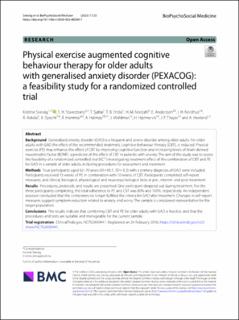| dc.contributor.author | Sirevåg, Kristine | |
| dc.contributor.author | Stavestrand, Silje Haukenes | |
| dc.contributor.author | Sjøbø, Trond | |
| dc.contributor.author | Endal, Trygve Bruun | |
| dc.contributor.author | Nordahl, Hans Morten | |
| dc.contributor.author | Andersson, E. | |
| dc.contributor.author | Nordhus, Inger Hilde | |
| dc.contributor.author | Rekdal, Åsa Kristine | |
| dc.contributor.author | Specht, Karsten | |
| dc.contributor.author | Hammar, Åsa Karin | |
| dc.contributor.author | Halmøy, Anne | |
| dc.contributor.author | Mohlman, J. | |
| dc.contributor.author | Hjelmervik, Helene | |
| dc.contributor.author | Thayer, Julian Francis | |
| dc.contributor.author | Hovland, Anders | |
| dc.date.accessioned | 2024-01-23T12:24:33Z | |
| dc.date.available | 2024-01-23T12:24:33Z | |
| dc.date.created | 2024-01-16T11:09:03Z | |
| dc.date.issued | 2023 | |
| dc.identifier.citation | BioPsychoSocial Medicine. 2023, 17. | en_US |
| dc.identifier.issn | 1751-0759 | |
| dc.identifier.uri | https://hdl.handle.net/11250/3113342 | |
| dc.description.abstract | Background
Generalised anxiety disorder (GAD) is a frequent and severe disorder among older adults. For older adults with GAD the effect of the recommended treatment, cognitive behaviour therapy (CBT), is reduced. Physical exercise (PE) may enhance the effect of CBT by improving cognitive function and increasing levels of brain-derived neurotrophic factor (BDNF), a predictor of the effect of CBT in patients with anxiety. The aim of the study was to assess the feasibility of a randomized controlled trial (RCT) investigating treatment effect of the combination of CBT and PE for GAD in a sample of older adults, including procedures for assessment and treatment.
Methods
Four participants aged 62–70 years (M = 65.5, SD = 3.2) with a primary diagnosis of GAD were included. Participants received 15 weeks of PE in combination with 10 weeks of CBT. Participants completed self-report measures, and clinical, biological, physiological and neuropsychological tests at pre-, interim- and post-treatment.
Results
Procedures, protocols, and results are presented. One participant dropped out during treatment. For the three participants completing, the total adherence to PE and CBT was 80% and 100%, respectively. An independent assessor concluded that the completers no longer fulfilled the criteria for GAD after treatment. Changes in self-report measures suggest symptom reduction related to anxiety and worry. The sample is considered representative for the target population.
Conclusions
The results indicate that combining CBT and PE for older adults with GAD is feasible, and that the procedures and tests are suitable and manageable for the current sample. | en_US |
| dc.language.iso | eng | en_US |
| dc.relation.uri | https://bpsmedicine.biomedcentral.com/articles/10.1186/s13030-023-00280-7 | |
| dc.rights | Navngivelse 4.0 Internasjonal | * |
| dc.rights.uri | http://creativecommons.org/licenses/by/4.0/deed.no | * |
| dc.subject | Generalised anxiety disorder | en_US |
| dc.subject | GAD | en_US |
| dc.subject | Cognitive behaviour therapy | en_US |
| dc.subject | CBT | en_US |
| dc.subject | Physical exercise | en_US |
| dc.subject | Older adults | en_US |
| dc.subject | Feasibility study | en_US |
| dc.title | Physical exercise augmented cognitive behaviour therapy for older adults with generalised anxiety disorder (PEXACOG): a feasibility study for a randomized controlled trial | en_US |
| dc.title.alternative | Physical exercise augmented cognitive behaviour therapy for older adults with generalised anxiety disorder (PEXACOG): a feasibility study for a randomized controlled trial | en_US |
| dc.type | Peer reviewed | en_US |
| dc.type | Journal article | en_US |
| dc.description.version | publishedVersion | en_US |
| dc.source.pagenumber | 10 | en_US |
| dc.source.volume | 17 | en_US |
| dc.source.journal | BioPsychoSocial Medicine | en_US |
| dc.identifier.doi | 10.1186/s13030-023-00280-7 | |
| dc.identifier.cristin | 2227547 | |
| dc.source.articlenumber | 25 | en_US |
| cristin.ispublished | true | |
| cristin.fulltext | original | |
| cristin.qualitycode | 1 | |

